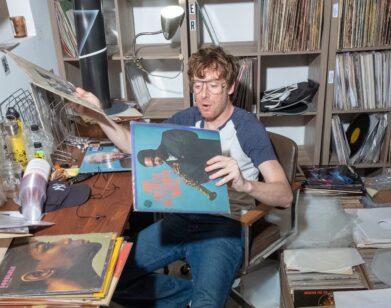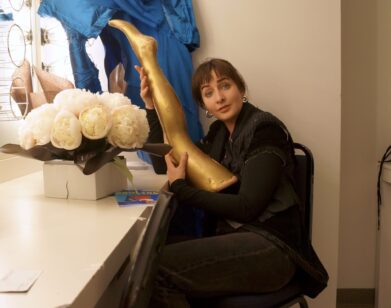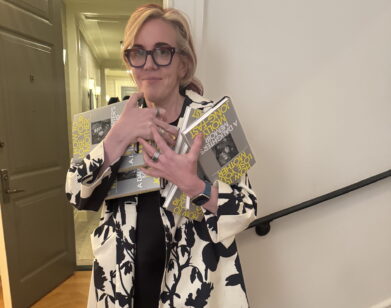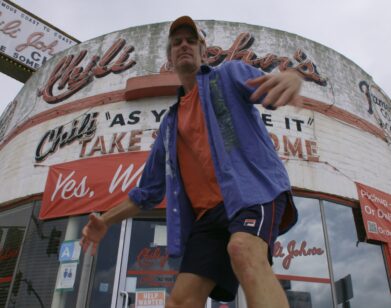Biba Lives
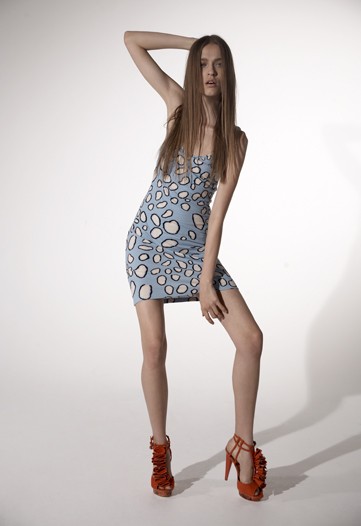
Barbara Hulanicki. Courtesy of Topshop
Barbara Hulanicki is a fantastic character. She was born in Poland but raised in England where she became a leading fashion illustrator. In 1964 she and her husband Stephen Fitz-Simon founded BIBA, a mail-order fashion business that would supply hordes of newly swinging birds their miniskirts at an affordable price just as London became the capital of pop culture. She has also enjoyed a remarkable career as an interior and exterior designer; she set the aesthetic tone for the revival of the Miami Art Deco District. We caught up with Hulanicki recently, as she passed through New York on the occasion of the opening of Topshop in Soho. Hulanicki has designed an exclusive line for the company which operates very much in the spirit of her historic brand BIBA. If you’re as young as you feel then I suppose the blonde, svelte and chic Barbara Hulanicki, who has been a major player in style for 45 years, is pushing 30.
GLENN O’BRIEN: I met you through Chris Blackwell of Island Records fame. You had decorated what was then his home in Jamaica, the Ian Fleming house, Goldeneye, and also you’d done his hotels.
BARBARA HULANICKI: Yes, I worked for Chris for about 15 years.
GOB: How did you get started with Chris?
BH: Well when my husband was alive we went to Miami, to do a club for Ronnie Wood on the beach.
GOB: Yeah.
BH: It was really very rough and dangerous at the time. We went for six months and we never left. After I finished the club, said, “Oh Chris Blackwell has got a hotel on the beach, do you want to do the hotel?” So I met Chris for the first time… and he gave me one corridor. What a job. In any case I passed that test, the corridor test. So then he gave me his apartment…
GOB: In the Marlin Hotel? (LEFT: BARBARA HULANICKI FOR TOPSHOP)
BH: Then I did the whole Marlin. Then he bought ten hotels like a job lot. I just kept working, one after the other. I always remember sending him a 1950s postcard of a woman in front of one of his hotels, The Tides. I wrote, “Oh look, here’s your hotel—what are you gonna do with it?” And he said, “Oh. I’ve forgotten all about that one.” You worked for Chris?
GOB: I worked for Chris for several years so I stayed at every one of those hotels. After that you did Goldeneye?
BH: Yes, and Pink Sands and Compass Point. Not only once, I did them like every five years. [CHUCKLES] When I was in the hotel I used to think, “I’m not gonna be here when this all falls apart.” Almost every time I was there. Anyway, now all the properties have been sold. It’s sad.
GOB: I was in Harbour Island right after Christmas. I stayed next door to Pink Sands and I sort of peeked over the fence. It looked kind of the same.
HB: I’m working for the new people. [LAUGHS] But it’s like sort of being haunted. Once you’ve been involved in a property… I mean, the other day, I met a very nice Brazilian man who just bought the Marlin and wants to bring it back. And I thought, “Oh God. That is not possible.”
GOB: So was Biba the first thing you ever did?
BH: Yes.
GOB: How did you start your career?
BH: I did fashion illustration for many years. I was doing editorials, I worked for The Times, Women’s Wear Daily, Vogue, Harper’s. I used to go to all the shows in Paris with the other girls. When I met my husband who was in advertising, he said, “You should really get back to designing.” At that period a lot of fashion was mail order, which was equivalent to websites now . So we started doing a little mail order and then we hit one really big one and then we found a location and then we opened a shop. And that sort of grew and grew from there.
GOB: What hit it big on the mail order, what was your star item?
BH: We did quite a few pieces and we were selling something like 200 of each one and we weren’t really making any money. It was like a nightmare to pack and ship, and we had to do it ourselves, and we were about to give up. And then the fashion editor of The [Daily] Mirror called me and she said, “I want a dress.. I want it for 25 shillings.” So I went to see her and I said, “Okay, let’s go dress for 25 shillings,” thinking it wasn’t going to work. I’ll never forget going home and Fitz’s says, “What a fucking price to doa dress without knowing anything!” And then we sold 17,000 of them.
GOB: Wow. And what was the name of that company?
BH: We called it “Biba’s Postal Boutique.” [LAUGHS]
GOB: Biba’s Postal Boutique, that’s really good. Where did you get the name Biba?
BH: That was an abbreviation of one of my sister’s names. We had to find a name overnight. And after that we had an entrance to all the great manufacturers. Suddenly we were big heroes with our dresses in one size, in one color. [CHUCKLES]
GOB: What color were they?
BH: Pink and white checked. [CHUCKLES] We thought you could buy a woven gingham anywhere, but it’s a very slow process, the weaving of the thing, so of course we couldn’t find any in England.
GOB: Really.
BH: We were sitting on all this cash, so this man phoned us from up from Manchester. And he arrived in a pair of spats with a bowler hat and an umbrella. And he said, “I’ve got all the gingham you want! Don’t worry!” So we handed him the cash and we thought, “Right, we got the fabric.” So there was a delivery, Fitz was still working for the advertising agency and I was at home doing drawings. And his secretary rings me up and she says, “There’s a delivery of gingham and many and many, many bolts of it sitting in the warehouse. But to me,” she said, “it doesn’t look like pink gingham, it looks,” she said, “it looks like red tablecloth fabric with checks this big.”
[LAUGHTER]
BH: It was meant to be like what Brigitte Bardot was always wearing, little gingham dresses. So they sent the swatch to me, I was in my cab. [GASPS] I nearly died. And what do, you know, the man came and gave us all the money back, I mean, it’s cuckoo when you think of it. But we found it eventually. The right size pink—
GOB: Do you still have one?
BH: No. [LAUGHTER]
GOB: So then how did the store happen?
BH: I saw this amazing old chemists’ lab that the whole interior had been taken to the V and A Museum. It was amazing. It was still in its original state. “Please, please, please, I want to do a shop.” Fitz wouldn’t talk about it after. Constance said, “Oh it’s terrible, don’t do it.” Eventually we had another mail order hit where we were selling about 1,000 pieces of one smock. So then Fitz decided to take the premises, the chemist’s. We had no space and we had the red one to pack and ship and I mean, this was an absolute nightmare. So all the stock is sitting in this chemist shop. And I open the door, it was a Saturday and Fitz was in the factory collecting more dresses or something. And, um, and suddenly I walked into the shop and it was full of girls trying the stuff on. So we were in business. [LAUGHS] One style, one color, one size. [LAUGHS]
GOB: What was your age group?
BH: Actually, when you think of it, it was very young, like 16. Because we were 24 and we were always considered really old.
GOB: And how much did the dress cost?
BH: The first one cost 25 shillings, 1.5. And the smocks that we were selling were 2 guineas. [LAUGHS] We said, “We must get like two shillings out of them.” It was before the days of checks or credit cards—it’s all cash. It’s funny now but it was terrifying.
GOB: Was it all your designs?
BH: Oh everything, yeah. We manufactured everything ourselves. And nothing else was happening there—for that age group. At that period they were starting to earn money. They didn’t spend money on food and not much on drink either. So they came in for a dress every week.
GOB: And were those mini dresses?
BH: Yeah. Now they’ve gotten minier and minier I think. Shorter and shorter.
GOB: I remember my first wife having Biba make-up. But was that after you re-launched? Didn’t you open a shop on the top of Harrods or something?
BH: Bergdorf Goodman in America. We had 600 feet in Bergdorf Goodman, but I think you’re thinking of the big store in High Street Kensington. We moved every two years, because we were just bursting at the seams. We did make-up in about our fourth year, which was really big. Then we exported to America and everywhere really.
GOB: So then what happened with Biba?
BH: We grew and grew and we took some partners about four years on, a family company that had 200 underwear shops. And we just exploded and we were with them for about six years. And we have a very happy relationship with them. And in that six years, we were in the High Street Kensington. It was completely defunct. It was an old area, with old carriage trade and nobody ever went there but there were these huge beautiful buildings. So then there was one of the buildings that was owned by Hugh Fraser, and he was going to demo it. And it was Deco and the English don’t understand that—well they do now, but they didn’t in those days. So Fitz just rang up Fraser and said, “I want to buy it. I want to take this building.” And he said, “Okay. If you can get me,” I can’t remember now, “X amount of money by tomorrow night.” [LAUGHS] Doing it up, it took 18 months. And past a quarter million pounds. Can you imagine six floors doing that? And that was kind of the end of us. It was sold it to Marks and Spencer before we even opened it.
GOB: So then you gave up the fashion for a while—
BH: Yeah.
GOB: To do interiors?
BH: We went to Brazil, and we worked with Cacharel and Fiorucci and Patatrone and then eventually I went into interiors. Now I’m back into fashion which is great! [CHUCKLES] Because they do all the terrible work of production for me.
GOB: Well I guess, I guess is Topshop like a modern day Biba?
BH: I guess yeah.
GOB: So what are the clothes like that you did for the Topshop?
BH: [CHUCKLES] “Listen to me, we don’t want Biba. We don’t want nothing like Biba.” I said to them: “Okay, great, I’m thrilled.” I gave them like 60 drawings which they picked 30. And as the process progressed, I said to them: “It looks very like Biba to me.” [CHUCKLES] “Use it, I don’t care.” They are a very, very good company. I am terribly impressed. Very family. It’s very, very nice seeing how they operate behind the scenes. What’s so exciting about this recession now is that people are starting to appreciate their sort of individual, approach to things.
GOB: The times encourages creativity. In early 80s New York, nobody had any money but everybody looked fantastic, you know? They went to thrift shops and they found amazing things and everybody had their own style. And the idea of buying a designer outfit didn’t exist.
BH: But people lost the capacity of using their brain. It’s all about the label. Not about the labels showing but subtlety of the labels.
GOB: Do you think you’re dressing the same age group as in Biba?
BH: I think they’re a bit older. A little bit. And more sophisticated, more worldly. In that period in England, they hadn’t traveled at all and they were very green. And now they’re brainwashed by Barbie doll. [CHUCKLES]
GOB: Somebody was trying to pitch me a story on Barbie and I’m saying “Why?”
BH: She’s been so damaging. [CHUCKLES] She has such abominable taste. But Topshop still works in the old way, which is amazing. This workroom is actually in the premises.
GOB: Is there anything else you’re working on that’s interesting?
BH: A few buildings. And I’m working with a very interesting Italian company on handbags that are still produced in Italy. You send them a drawing and usually you’d think, “Oh God it’s going to be awful.” But then they put so much into the production it comes out fabulous fabulous. It’s a group called Coccinelle—a huge, sort of mid-priced company. They just signed me up for five years and I said, “Do you realize how old I am?” [LAUGHS]
GOB: Skills are hard to come by.
BH: Today the experience is at school and that isn’t it. The wonderful letters added on to your name, they can’t do a thing. School is a tunnel vision, in America especially I think.
GOB: Your drawing skill is almost an endangered craft.
BH: I’ve gone back to illustration now and certainly when people look at it they’ll say, “But it’s a drawing.”[LAUGHS] “Yes, it’s a drawing.” I’ve found that most of the trouble I’ve had working with architects on interiors is that you do a hand drawing and they look at it, and they’re very confused because it’s not a computerized thing—
GOB: I’ve heard that said about architecture a lot, that the art of drawing has been totally lost.
BH: In Miami they’re building all these hideous monstrosities. It’s just so easy to be an architect, once you’ve got the ability to do your computer drawings. They just knock off each other. There’s nothing creative in any of them. There’s just one or two really good architects. The rest are just rubbish. I blame all the craziness of people buying houses, re-doing them and selling them, on these programs on television where they are redoing your homes and kitchens.
GOB: People are building 15,000-square-foot enormous houses that are going to be extremely impractical to heat and cool. They’re doomed. Yet in suburban Connecticut there are masterpiece modern houses and people have been bulldozing them because the house is 2,000 square-feet. Philip Johnson’s Glass House…
BH: Is quite small.
GOB: By modern standards it’s tiny, yeah. But what do you need? I don’t need a gym in my house. [CHUCKLES] Or a theater.
BH: Like, there are crazy developers in London who build these apartments with fridge for your furs.
GOB: Have you worked with a lot of architects?
BH: I have worked with some horrible idiots in my life. [LAUGHS] You learn the pattern of how architects work and the thing is not to fight it. Just to be very quiet, let them get on with it and let them really mess it up. [LAUGHS] And then be the hero, the cavalry. [LAUGHS] Because the two jobs are not compatible at all.

